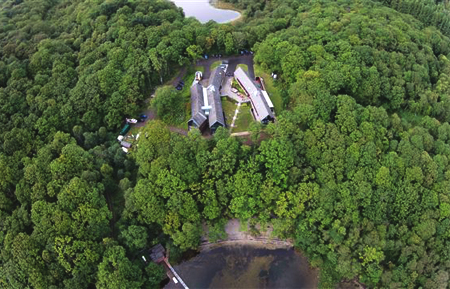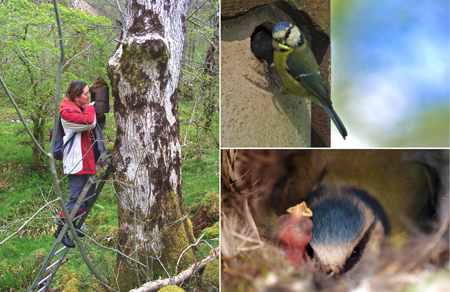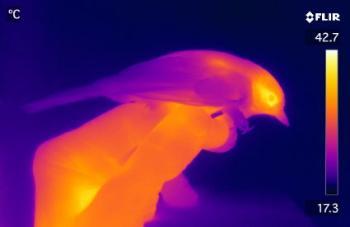Woodland bird study system
Background
 Our field station SCENE on Loch Lomond is situated within one of Britain’s largest semi-natural forests, dominated by oak and other deciduous species (“temperate rainforest”).
Our field station SCENE on Loch Lomond is situated within one of Britain’s largest semi-natural forests, dominated by oak and other deciduous species (“temperate rainforest”).
At 57 N, this woodland is a high-latitude example of Atlantic oak forest, with characteristically high biodiversity, and is a designated “Special Area for Conservation”.
The woodland supports a high abundance of invertebrates, which in turn sustains high densities of woodland birds (up to 1500 breeding pairs per km2). The proximity to the state-of-the art facilities at SCENE provides an ideal background for studies of ecology, physiology and genetics of woodland species.
The study system
 Over the last decade, we have developed an extensive system of nest boxes for hole-nesting songbirds (mostly Blue and Great Tit, Cyanistes caeruleus and Parus major).
Over the last decade, we have developed an extensive system of nest boxes for hole-nesting songbirds (mostly Blue and Great Tit, Cyanistes caeruleus and Parus major).
We have placed almost 500 boxes in the woodlands around SCENE. The SCENE’s Bird Research Group has recorded annually the phenology data on bird breeding, tree bud-burst and caterpillar peak. In addition, we have established several techniques for remotely monitoring birds and their activities throughout the year.
This includes PIT tag readers in nest boxes and at bird feeders, radio-telemetry equipment and different ways of measuring body temperature. Further technical refinements are in piloting stages.
Research applications
 We access sub-sets of our nest boxes for experimental studies, for example on thermal biology, predation-starvation trade-offs, stress and parental behaviour, while leaving others untouched for inter-annual comparisons.
We access sub-sets of our nest boxes for experimental studies, for example on thermal biology, predation-starvation trade-offs, stress and parental behaviour, while leaving others untouched for inter-annual comparisons.
We can also use the nest boxes around SCENE in conjunction with nest boxes that have been placed in the city of Glasgow and at sites along this Dr Ross MacLeod.
Contacts
rural-urban gradient SCENE-Glasgow (Barbara.Helm@glasgow.ac.uk)
(Ruedi.Nager@glasgow.ac.uk)
(Ross.MacLeod@glasgow.ac.uk)
Selected publications
- Ramsay, S.L. & Houston, D.C. 1997. Nutritional constraints on egg production in the blue tit: a supplementary feeding study. Journal of Animal Ecology 66: 649-657.
- Ramsay, S.L. & Houston, D.C. 1998. The effect of dietary amino acid composition on egg production in Blue Tits. Proceedings of the Royal Society B. 265:1-5.
- Ramsay, S.L.; Houston, D.C. 1999. Do acid rain and calcium supply limit eggshell formation for blue tits (Parus caeruleus) in the UK? Journal of Zoology 247 121-25
- Henderson. L.J., Heidinger, B.J., Evans, N.P. & Arnold K.E. 2013. Ultraviolet crown coloration in female blue tits predicts reproductive success and baseline corticosterone. Behavioral Ecology, 24, 1–7.
- Herborn, K.A., Heidinger, B. J., Alexander, L. & Arnold, K.E. 2014. Personality predicts behavioral flexibility in a fluctuating, natural environment. Behavioral Ecology doi: 10.1093/beheco/aru131
- Larcombe SD, Mullen W, Alexander L, Arnold KE 2010. Dietary antioxidants, lipid peroxidation and plumage colouration in nestling blue tits Cyanistes caeruleus. Naturwissenschaften. 97(10):903-13. doi: 10.1007/s00114-010-0708-5. Epub 2010 Sep 14
- Arnold, K. E., Ramsay, S. L., Henderson, L. & Larcombe, S. D. 2010. Seasonal variation in diet quality: antioxidants, invertebrates and blue tits Cyanistes caeruleus. Biological Journal of the Linnean Society. 99: 708 – 717.
- Arnold, K. E., Ramsay, S. L., Donaldson, C. & Adam, A., 2007. Parental prey selection affects risk–taking behaviour and spatial learning in avian offspring. Proceedings of the Royal Society B–Biological Sciences, 274: 2563–2569.

